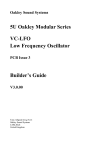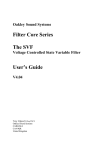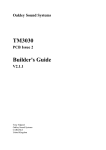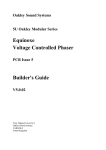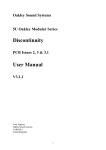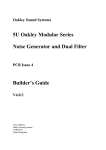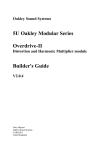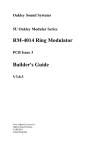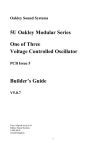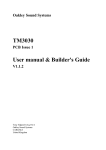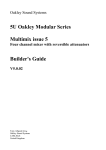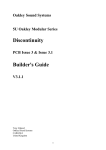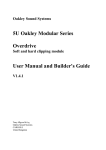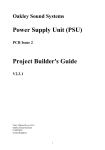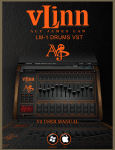Download COTA issue 2 Builder`s Guide
Transcript
Oakley Sound Systems 5U Oakley Modular Series COTA Voltage Controlled Filter PCB Issue 2 Builder's Guide V2.0.1 Tony Allgood B.Eng PGCE Oakley Sound Systems CARLISLE United Kingdom Introduction This is the Project Builder's Guide for the issue 2 COTA 5U module from Oakley Sound. This document contains a basic introduction to the board, a full parts list for the components needed to populate the boards, a list of the various interconnections and a 'how it works' section. For the User Manual, which contains an overview of the operation of the unit and the calibration procedure, please visit the main project webpage at: http://www.oakleysound.com/cota.htm For general information regarding where to get parts and suggested part numbers please see our useful Parts Guide at the project webpage or http://www.oakleysound.com/parts.pdf. For general information on how to build our modules, including circuit board population, mounting front panel components and making up board interconnects please see our generic Construction Guide at the project webpage or http://www.oakleysound.com/construct.pdf. 2 The COTA PCB The issue 2 prototype COTA in a 1U MOTM format panel with Schaeffer's natural finish. Note the use of the Sock8 socket board to make wiring so much easier and quicker. I have provided space for the three main control pots on the PCB. If you use the specified pots and brackets, the PCB can be held firmly to the panel without any additional mounting procedures. The pot spacing is 1.625” and is the same as the vertical spacing on the MOTM modular synthesiser. The pots are; cut off frequency, resonance and frequency CV depth. The design requires plus and minus 15V supplies. The power supply should be adequately regulated. The current consumption is about 20mA for each rail. Power is routed onto the main PCB by either a four way 0.156” MTA156 type connector or the special five way Synthesizers.com MTA100 header. You could, of course, wire up the board by soldering on wires directly. The four pins are +15V, ground, earth/panel ground, -15V. The earth/panel connection allows you to connect the metal front panel to the power supply’s ground without it sharing the modules’ ground line. More about this later. This unit will also run from a +/-12V supply with a slight reduction in dynamic range. The PCB has four mounting holes for M3 bolts, one near each corner. These are not required if you are using the pot brackets. The board size is 112mm (deep) x 104mm (high). The main board has been laid out to accept connection to our Sock8 socket board. This small board speeds up the wiring of the six sockets and reduces the chances of building mistakes. 3 Parts List For general information regarding where to get parts and suggested part numbers please see our useful Parts Guide at the project webpage or http://www.oakleysound.com/parts.pdf. The components are grouped into values, the order of the component names is of no particular consequence. A quick note on European part descriptions. R is shorthand for ohm. K is shorthand for kiloohm. R is shorthand for ohm. So 22R is 22 ohm, 1K5 is 1,500 ohms or 1.5 kilohms. For capacitors: 1uF = one microfarad = 1000nF = one thousand nanofarad. To prevent loss of the small ‘.’ as the decimal point, a convention of inserting the unit in its place is used. eg. 4R7 is a 4.7 ohm, 4K7 is a 4700 ohm resistor, 6n8 is a 6.8 nF capacitor. Resistors 1% 0.25W metal film types are to be recommended simply because they are better quality components. However, 5% ones can be used in all places if you wish. R23 will probably have to be a 5% type since getting hold of a 1% metal film resistor in this value is sometimes not trivial. NOTE: The Filter Core format does not need R11 and R20 so these parts can be omitted if you are building the 1U version of the filter. 100R 470R 1K 1K +3000ppm/K PTC 4K7 15K 33K 47K 68K 75K 100K 120K 150K 220K 240K 560K 1M 1M5 R14 R35 R7, R26, R46, R45, R36, R8, R27, R39, R52, R51, R40 R33 R15 R9, R2, R1, R28, R19, R18, R41, R48, R53, R47 R32 R10 R24, R37, R49 R42, R29, R55 R6, R4, R3, R16, R20, R25, R38, R50 R31 R12, R11, R13, R44, R34, R30, R54 R5, R21 R43 R17 R22 R23 4 Capacitors 330pF * 100nF, 63V axial ceramic 470nF,63V polyester 1uF, 63V polyester 2.2uF, 25V electrolytic C1, C6, C8, C16 C5, C3, C13, C12, C10, C11, C4 C2 C9, C17, C7 C14, C15 * The 330pF should be a good quality capacitor such as silver mica, polypropylene or polyester. The lead spacing is 5mm or 0.2”. Discrete Semiconductors 1N4148 signal diode BC550 NPN transistor BC560 PNP transistor J201 N channel JFET D1, D2 Q4 Q3 Q1, Q2, Q5, Q6 Integrated Circuits LM13700 dual OTA TL072 dual op-amp LF412A dual op-amp U2, U4 U1 U3, U5 Trimmers 100K multiturn trimmer 20K multiturn trimmer 10K horizontal 6mm trimmer TUNE V/OCT RES Potentiometers (Pots) All pots Alpha 16mm PCB mounted types 47K or 50K linear 10K linear CV1-DEPTH, FREQUENCY FEEDBACK Two 16mm pot brackets. 5 Miscellaneous Leaded axial ferrite beads L1, L2 MTA156 4 way header MTA100 6-way header PSU PWR – Oakley/MOTM power supply – Synthesizers.com power supply Molex/MTA 0.1” header 6-way Molex/MTA 0.1” housing 6-way UPR UPR – for connecting to sockets – for connecting to sockets Molex/MTA 0.1” header 8-way Molex/MTA 0.1” housing 8-way LWR LWR – for connecting to sockets – for connecting to sockets Other Parts Required Switchcraft 112APC 1/4” sockets Eight off mounted either on the Sock8 board or on panel Three 27mm knobs. At least one cable tie to hold Q3 and Q4 together. Around 2m of insulated multistrand hook up wire for the switch and socket connections. Additional components required if using optional Sock8 board Molex/MTA 0.1” header 6-way Molex/MTA 0.1” header 8-way UPR LWR Molex/MTA 0.1” housing 6-way Molex/MTA 0.1” housing 8-way UPR LWR 112APC Switchcraft 1/4” socket SK1, SK2, SK3, SK4, SK5, SK6, SK7, SK8 If using Molex KK you'll also need at least 28 crimp terminals. Suitable lengths of wire to make up the two interconnects and three cable ties. You need to fit a wire link in L1 on Sock8 issue 2 boards. 6 Additional parts required for the 2U version You won't be needing the Sock8 board since all the sockets will need to be wired up individually. Make sure that R11 and R20 are fitted. Miscellaneous 1/4” sockets IN3, 1V/OCT Offboard Pots (2U format only) 47K or 50K Log 47K or 50K Linear IN1, IN2, IN3 CV2 Close up of the board showing the two bipolar transistors coupled together with a cable tie. You could use some thermal paste between them. This would thermally couple the two devices even closer but it is probably not worth it for this application. Note also R33. This is the small temp co (positive temperature coefficient or PTC) resistor. 7 Connections Power connections – MOTM and Oakley The PSU power socket is 0.156” Molex/MTA 4-way header. Friction lock types are recommended. This system is compatible with MOTM systems. Power Pin number +15V Module GND Earth/PAN -15V 1 2 3 4 Pin 1 on the I/O header has been provided to allow the ground tags of the jack sockets to be connected to the powers supply ground without using the module’s 0V supply. Earth loops cannot occur through patch leads this way, although screening is maintained. Of course, this can only work if all your modules follow this principle. Power connections – Synthesizers.com The PWR power socket is to be fitted if you are using the module with a Synthesizers.com system. In this case you should not fit the PSU header. The PWR header is a six way 0.1” MTA, but with the pin that is in location 2 removed. In this way location 3 is actually pin 2 on my schematic, location 4 is actually pin 5 and so on. Power Location number Schematic Pin number +15V Missing Pin +5V Module GND -15V Not connected 1 2 3 4 5 6 1 2 3 4 5 +5V is not used on this module, so location 3 (pin 2) is not actually connected to anything on the PCB. If fitting the PWR header, you will also need to link out pins 2 and 3 of PSU. This connects the panel ground with the module ground. Simply solder a solid wire hoop made from a resistor lead clipping to join the middle two pads of PSU together. 8 Building the 1U Filter Core module using the Sock8 board This is the simplest way of connecting all the sockets to the main board. The Sock8 board should be populated in the way described in our construction guide found on the project webpage. There are only two headers, UPR (for upper) which is six way, and LWR (for lower) which is eight way. Both headers are fitted to the bottom side of the board. If you have an issue 2 Sock8 board don't forget to fit a wire link in position L1. You need to make up two interconnects. The six way one should be made so that it is 80mm long. The eight way should be made to be 130mm. The prototype unit showing the detail of the board to board interconnects. Here I have used the Molex KK 0.1” system to connect the Sock8 to the main PCB. 9 Building the 1U Filter Core module by wiring the sockets manually If you have bought Switchcraft 112A sockets you will see that they have three connections. One is the earth or ground tag. One is the signal tag which will be connected to the tip of the jack plug when it is inserted. The third tag is the normalised tag, or NC (normally closed) tag. The NC tag is internally connected to the signal tag when a jack is not connected. This connection is automatically broken when you insert a jack. Once fitted to the front panel the ground tags of each socket can be all connected together with solid wire. I use 0.91mm diameter tinned copper wire for this job. It is nice and stiff, so retains its shape. A single piece of insulated wire can then be used to connect those connected earth tags to pin 1 of LWR. Pin 1 is the square solder pad. All the other connections are connected to the signal lugs of the sockets. The tables below show the connections you need to make: UPPER Pin Pad name Socket Connection Lug Type Pin 1 Pin 2 Pin 3 Pin 4 Pin 5 Pin 6 BP_OUT Not connected FBK_NC FBK_IN module ground IN1 Connect to BAND PASS Signal lug Connect to FEEDBACK Connect to FEEDBACK Connect to IN1 & IN2 Connect to IN1 NC lug Signal lug NC lugs Signal lug LOWER Pin Pad name Socket Connection Lug Type Pin 1 Pin 2 Pin 3 Pin 4 Pin 5 Pin 6 Pin 7 Pin 8 Panel ground LP_OUT 1V/OCT_IN 2P_LP_OUT module ground IN2 module ground CV1_IN Connects to all sockets Connect to -24dB/OCT Connect to 1V/OCT Connect to -12dB/OCT Connect to 1V/OCT Connect to IN2 Connect to CV1 Connect to CV1 Ground lugs via wire frame Signal lug Signal lug Signal lug NC lug Signal lug NC lug Signal lug 10 2U COTA full format I am not going into great detail with this format as the PCB has been primarily designed with the 1U filter core module in mind. However, I will mention a few things that may be useful to you if you do decide to build the larger format design. The 2U format contains ten sockets and four additional pots. You can use any pots you like, but I am rather partial to the 16mm Alpha pots sold by Banzai which have the solder lugs and not the usual PCB mounted ones you have used on the board. You may be tempted to use the larger 24mm Alpha pots, indeed, these are great pots, but the width of them may mean that the top pot will clash with your choice of mounting rail. Your first job will be to ground the earth lugs on each socket. Do this by joining the earth lugs of each vertical row of sockets together first with stiff single core wire. Then use another piece of solid core wire, going across horizontally, to connect all four vertical wires together. Take a single insulated piece of wire back to on the PCB and connect it to pin 1 of the header LOWER. This now connects all the sockets' ground lugs to earth/pan connection on the PCB. This in turn goes, via pin 3 of the PSU header, back to the power supply. It is also advisable to ground the NC lugs of the six input sockets too. Do this in much the same way as you have 'commoned' the earth lugs. Simply connect all three sockets' NC lugs in each of the right hand columns together with two pieces of stiff wire. Then, with two more short lengths of insulated multistrand wire, connect the stiff wire pieces to pins 5 and 7 of LOWER respectively. The connections of the signal lugs of the CV and audio output sockets that go directly to the PCB are summarised below: UPPER Pin Pad name Socket Connection Lug Type Pin 1 Pin 2 Pin 3 Pin 4 Pin 5 Pin 6 BP_OUT Not connected FBK_NC FBK_IN Module ground Not connected Connect to BAND PASS Signal lug Connect to FEEDBACK Connect to FEEDBACK NC lug Signal lug 11 LOWER Pin Pad name Socket Connection Lug Type Pin 1 Pin 2 Pin 3 Pin 4 Pin 5 Pin 6 Pin 7 Pin 8 Panel ground LP_OUT 1V/OCT_IN 2P_LP_OUT module ground Not connected module ground CV1_IN Connects to all sockets Connect to -24dB/OCT Connect to 1V/OCT Connect to -12dB/OCT See text Ground lugs via wire frame Signal lug Signal lug Signal lug NC lugs See text Connect to CV1 NC lugs Signal lug All your other connections will be made via the four two way 0.1" headers that are situated on the board near the pots. These are labelled appropriately to help you connect up your module correctly. They are IN-1, IN-2, IN-3 and CV2. Pots have three pins. Two of these pins will be connected to PCB, whilst the remaining one will be connected to the appropriate socket's signal lug. The middle pin of the pot, the wiper, will carry the signal to the appropriate header on the PCB. The pots' wires will attach to the underside of the board at each header, and thus be soldered from the topside of the board. For each header, pin 1 is connected to the wiper of the pot. Pin 1 is the square pin so it is easily spotted even from the underside of the board. The pot has two other pins, one will be connected to ground, the other to the signal lug on the socket it controls. With pins facing down and looking at the back of the pot, the right hand pin should go to the ground connection of the header, that is pad 2 on each of the headers. Take a wire from the right hand pin to the round pad on the PCB next to the one that the associating wiper connects. Now each pot will have one unsoldered pin left. Connect these to the appropriate socket. The wire should go to the signal lug of the socket. IN 1 goes to the signal lug on the socket labelled IN 1, and so on. There are a quite lot of wires here, but it should be quite neat once it is all done. 12 Circuit description The design of the Oakley Cascaded Operational Transconductance Amplifier filter is very traditional and I am making no claims for originality. The design topology is found in many synthesizers. It is simply four voltage controlled low pass elements put in cascade to give us a great sounding four pole low pass filter. Each low pass element is made from an integrator, built from an OTA and a timing capacitor, a buffer of some sort, and some resistative feedback. The active parts of the design were put into chip form as the SSM2040 (eg. Prophet 5 rev 2, Octave CAT SRM) , CEM3320 (eg. Prophet 5 rev 3 and Oberheim OB-Xa) and the IR3109 (eg. Jupiter 8 and SH-101). Each one of these chips behaves differently in terms of signal linearity, hence their different sounds, but the internal topology was much the same. The Moog ladder can be thought of as a cascaded design too although this is constructed so differently to warrant its own classification. Roland initially used transistor Moog ladders and then diode ladders in their first synths like the SH-3, SH-5 and SH-2000. However, later synths such as the SH-7, SH-1 and System 700 used a cascaded design built from CA3080s. The 3080 is an operational transconductance amplifier, OTA, which is probably more commonly used as a VCA, but here it was used as the control element in the integrator. Later Roland synths such as the SH-09 used their own version of the CA3080, the BA662, as the OTA. Later still, the JP-8 and SH-101 used four matched OTAs in one package complete with its own onboard exponential convertor, this was the IR3109 filter chip. The fundamental sound was similar to the early more discrete design – although there are some sonic differences between all the versions when you listen more closely. The Oakley design is a four stage filter that uses the well respected LM13700 as the OTA element. There are two OTAs in one LM13700, and the two internal devices are quite similarly matched. The OTA part of the LM13700 can be considered to be very similar to the CA3080 and probably the OTA part of the BA662. Before we look at the core in detail, we need first to have a look at how the signals are treated before they reach the filter circuitry. There are three main audio inputs to the COTA, each one has a two pin header with the second pin being used for a ground, or 0V, connection. These are shown on the schematic as IN1, IN2 and IN3. Two of these inputs have an alternative input solder pad – these are to be used in the 1U Filter Core module. These have no individual ground since they will going straight to the input jack socket's signal lug. U3 and its associating components form a inverting summing circuit. This common circuit block is used to add the various input signals together. The gain of the summing is set to be roughly a third. That is, if all three inputs are at 5V peak, the output at pin 1 of U3 will be approximately 5V peak. Note though that it is an inverting summer, which means that the phase of the summed output is in opposition to the input signals. This means a negatively going signal will be converted to a positive going one. C2 provides AC coupling of the audio output of the summer. This acts to block any DC or very low audio frequencies. As we have seen the whole filter is built from four identical single 13 pole low pass filters. Each filter element is basically a current controlled integrator with some negative feedback to provide the required low pass function. Let us look at the first element in the signal chain, that is the one made based around U2a, Q1 and C1. The first element is identical to the others but does have some additional bits added to allow for the resonance feedback input. We'll look at this particular bit in more detail later. The OTA is very useful device. It produces an output current that is proportional to the difference in voltage between its two inputs, pins 4 and 3. Furthermore, that output current is also proportional to current drawn from a control pin, which is pin 1 for this integrator. This control current is called Iabc - abc standing for 'amplifier bias current'. In this application we can see that one of the inputs to the OTA is tied only to ground through a low value resistor, R7. Thus our only voltage input is at pin 4 which is the inverting input. This means that our output current is proportional, but of opposite polarity, to the voltage at pin 4. That current is used to charge and discharge the timing capacitor, C1. The more negative the input voltage, the faster the capacitor charges. The more positive the input voltage the faster the capacitor discharges. This is the action of an integrator. Remember too the affect of Iabc. This controls the output current too, and a bigger Iabc will mean a faster rate of charging and discharging. Iabc is provided by the control voltage (CV) input circuitry and we will look at this later, but at the moment we can simply think of Iabc being larger for higher cut-off frequencies. When you charge a capacitor up the voltage across it changes. It is this voltage that we are interested in since this is what we want to hear. However, we can't just take this voltage from the capacitor because by doing so we will steal current from it and affect the output level. So we use a buffer made from a JFET, Q1, and a resistor, R9. This simple circuit allows us to make a copy of the capacitor voltage without affecting that voltage itself. That copy is presented at the source pin of the JFET. There's actually a small error in this copy, in that it is slightly higher in value than that across the capacitor. However, this is no issue because the error is constant and we're only interested in the audio part of the signal, the wiggly bit, and not any constant DC term. C9, a largish value capacitor, will block the DC and allow the audio through. Note R6, this is critical to the operation of the low pass element. This passes back some of the output signal back to the input. Actually, it is passing current back to the input and because it is of opposite polarity to the input signal it acts against it and regulates the output. It is this negative feedback that gives us our overall low pass filter response. Without R6, we just have an integrator and the voltage across the capacitor would simply rise and rise with any positive input voltage, or fall and fall with any negative signal. Of course, it can't rise or fall beyond the limits of the power supply, but even so, it wouldn't give us the desired low pass effect. I will point out one more thing about this feedback path. The value of the feedback resistor, R6, in conjunction with the value of R5, sets the gain of the filter stage. Unlike many cascaded OTA designs, this is not set to one. In other words, the Oakley COTA is unusual in that the passband signal level changes as it runs through the filter. The first stage there is an gain of approximately one half. This is to reduce the large signal levels coming out of the audio summing circuit. Then the other three following stages have a gain of approximately 1.47. 14 This means that when the filter is put into self-oscillation the magnitude of the resultant sine wave output is the same from each filter stage. However, it also means that the audio level gets hotter as it works its way through the filter. This means that any non-linearities in the circuits are going to be exacerbated as the signal progressively gets closer to overdriving the sensitive OTA input circuitry. So why have I done this because surely this is a problem? Over the years I have heard many different synthesisers and some I like a lot, and some not so much. I analysed the circuits of one of my favourite synths and wondered why this 1978 synth sounded better than those that followed it. One of the differences was the filter gain structure and this one had been made for constant oscillation levels, but the later synth designs had unity gain in each filter stage. So what I have done for the COTA is copied the unusual gain structure from that wonderful 1978 synthesiser. So which synth is it? You'll have to guess. You can of course change the values of R24, R37 and R49 to 100K to give each stage unity gain. I found the basic sound to be much the same, but there was something smoother sounding about the earlier circuit value. Why not experiment yourself? As I have hinted earlier all OTAs are non linear. This means that they affect the input more than they should and produce audible distortion at their outputs. Now the LM13700 features a simple waveshaping circuit, based around some internal diodes, at each of its two inputs. These waveshaping circuits produce their own non-linearities, but the shape of these non linearities are designed to cancel out the other ones present in the rest of the chip. The waveshapers are 'turned on’ by the presence of currents at pin 2 and pin 15. However, in this design I have chosen not to utilise the diodes. This will decrease the overall signal to noise ratio, ie. make the module more noisy, but it will allow the signal to gracefully overdrive. It also makes it closer to the behaviour of the CA3080 and hence give the module a more classic vintage tone. The COTA has three audio outputs. The -12dB/octave output is taken from the output of the second stage of filtering. The -24dB/octave output is taken from the final fourth stage. Both of these are inverted and amplified by identical op-amp circuits, based around U3b and U5b respectively. C7 and C17 provide AC coupling – allowing the audio to go through but blocking the DC voltage output of the filter stages. The inversion of these stages is not a problem since it simply reverses that was done by the audio input summing circuit, U3a. The gain of each output stage is set to -2, so as to bring the output signal level, when the filter is oscillating, to roughly 5V peak, or 10V peak to peak. It should be noted that due to the non unity gain of each filter stage, the passband audio signal does get larger as it works its way down the filter stages. Thus the -24dB/octave output will be greater than the -12dB/octave output. It may not necessarily be louder though, since the -12dB/octave output will be brighter in tone. The bandpass output is a derived output and not generated in a true bandpass filtering process. The fourth stage output is summed with the first stage output in a specific proportion. This summing allows for the frequencies below the cut-off frequencies to be attenuated whilst reinforcing those above it. This gives an eventual overall roll off of -6dB/octave above and below the cut-off frequency. 15 The actual summing proportions were determined firstly mathematically and then verified empirically. To create a bandpass output the mathematics tells us that the output of the first and fourth filter stages shall be summed equally. However, the mathematics assumes that each filter stage has a gain of unity - ours do not. Each of our filter stages is designed to produce an equal output when oscillating and not for a unity gain in the passband. In practice this means that each of our filter stages has the effective gain of around 1.47. Over the three stages, from first to fourth, this means we have an overall gain of 3.18 or so. Thus R43 should be 3.18 times bigger than R42. If we choose R42 to be 75K, R43 should then be 238K. Using 240K is the nearest real resistor value. The feedback path is normally wired from the fourth output stage back to the input – although the feedback input socket does allow you to change this. For the moment we will consider the normalised route from the -24dB/octave output via the RES trimmer and R35 to the FBO solder pad. This is then wired to the normalised lug of the feedback socket, which when no jack is inserted, simply carries the signal back to the FBI solder pad. The amount of feedback routed back to the input stage of the first filter element is controlled by the 'FEEDBACK' pot, D1 and D2 act as voltage limiters preventing feedback runaway and ever increasing selfoscillation. R1 limits the input current and prevents these diodes from having a detrimental effect on any input plugged into the feedback socket. Even so it should be noted that the feedback input is quite low in impedance compared with the minimum value of 47K of ordinary Oakley audio inputs. However, this should not cause any problems in practice. Iabc is provided by Q3 which acts as an exponential convertor and voltage to current convertor in one. It is driven by an emitter follower, Q4. Both transistors act together to eliminate the effects of Vbe drift. Vbe drift, if uncompensated, would cause the filter’s cut off frequency to change with temperature. However, any drift in Vbe in Q3, is effectively cancelled out by an opposite drift in Q4. In theory, the transistors must be matched for Vbe. However, this is not really necessary in my opinion. Vbe drift is not the only source of inaccuracy in the exponential convertors. Drift in the scaling factor caused by a changing ambient temperature can be cancelled by the PTC resistor R33. The PTC resistor’s resistance goes up by 0.30% every degree C, and this almost compensates for the -0.35% drift in scaling. It is not essential to get this exactly cancelled in a VCF, since the imperfections create only a slight change in the tonal characteristics as the temperature changes. U1b acts a summing amplifier taking all the CV inputs together to create one CV line to control the exponential convertor. V/OCT sets the relationship between the input voltage and the affect on the cut-off frequency. It is normally trimmed so that an increase in 1V on the KBD input will produce a one octave shift in cut-off frequency. U1a and associating components act as a reversible attenuator. This is based on a simple but very effective circuit. I first saw it in the classic text ‘The Art of Electronics’ by Horowitz and Hill. They probably aren’t the originators of the circuit. The best way to figure out how it works is to think what happens when the pot wiper (pin 2) is moved to each of the ends. When the pot is turned fully counter clockwise, the wiper connects to ground, pin 1. Thus, the non-inverting input to the op-amp is now connected to 16 ground. The pot has no effect on the circuit other than loading the input, which we can ignore. One of the golden rules of op-amps is that both inputs must be at the same voltage. (This is not actually true, but it is a useful starting point.) If the non-inverting input is at ground, then so must the inverting input. A voltage at the input is turned into a proportional current through R3, because one end is at ‘ground’. The op-amp acts in such a way as to produce the same current through its feedback loop, namely R4. It does this by changing the voltage on its output. Because the resistors are the same value, you need to have the same voltage but of opposite sign appearing at the output of the op-amp to produce the same current. Thus the op-amp is working as an inverting amplifier with a gain of -1. So if the voltage on CV1 was 3V, the output of U1a would be -3V. Now, let us move the wiper to the opposite side, that is, fully clockwise. This one is harder to figure out. This means that the non-inverting input is connected to the input signal. The golden rule says that the inverting input is also at the same voltage. This means that no current flows through R3. Why? Because you need a difference in voltage across a device to create a current. So if there is no current through R3; there is none flowing through the feedback resistor R4. To do this, the op-amp must produce the same voltage at its output as on its two inputs. Thus the gain of the op-amp is +1. This means a +3V signal going in, ends up as a +3V signal going out. I will leave it to you to prove that the central position of the pot gives no output. Power is supplied via the usual four way MTA/Molex connector or the five pin but six way Dotcom power header. As is the custom for Oakley modules, I have used ferrite beads to act as high frequency filters on the power lines. Decoupling at the point of entry is provided by C12 and C14 for the positive rail, and C13 and C15 for the negative rail. Additional decoupling is also provided elsewhere on the board by the other capacitors shown at the bottom of the schematic. All these capacitors keep the power supply clean of noise, and provide a reservoir for the little bursts of current that the circuit takes in normal operation. 17 Testing, testing, 1, 2, 3... Apply power to the unit making sure you are applying the power correctly. Check that no device is running hot. Any sign of smoke or strange smells turn off the power immediately and recheck the polarity of the power supply, and the direction of the ICs in their sockets. Assuming everything is OK so far, it is time to apply an audio input. Use a bright signal like a sawtooth output from a VCO. Middle A, 440Hz is a good note to use. Moving the FREQUENCY control should produce the usual and distinctive filter effect from the -24dB/octave low pass output. From the -12dB/octave pass output, you should hear the same sort of sound, but slightly brighter and more electronic in tone. It will also be slightly quieter in volume than the -24dB/octave output. The band pass output should produce a sort of wah-wah sound as the Frequency pot is moved back and forth. Turning the Resonance up will accentuate the ‘electronic’ nature of the sound on all three outputs. Remove the audio input and check that at just under maximum resonance the filter output will oscillate across the whole audio band. Beware, it is quite possible to get this filter to oscillate above the range of hearing. So be careful so as not to damage your studio monitor’s tweeters. Listening to the -24dB/octave low pass output with the sawtooth input connected again, patch a LFO or EG output to the CV inputs. The 1V/octave input should produce large sweeps of cut-off. Check also that with the LFO or EG connected to the CV1 input, the CV1 pot allows you to control the depth of the sweep. Fully clockwise the CV1 input should produce very deep sweeps. Notice that the minimum sweep depth should occur with the CV1 pot at its mid point. Use a sawtooth waveform on your LFO, and see if the CV1 depth pot allows you to invert the modulation input. You should get a ‘dow-dow-dow...’ from one side and a ‘yit-yit-yit...’ from the other. Check that both the audio inputs should behave identically. If all this happens, the chances are that you have a working module. 18 Trimmers There are three trimmers on the PCB. V/OCT: This adjusts the scaling of the exponential inputs. Adjust this so that there is an octave jump in cut-off frequency when the 1V/OCT input is raised by one volt. Plug a 1V/octave source into the 1V/OCT socket. This may be your keyboard’s pitch CV output, or from the CV output of a midi-CV convertor. Set the Resonance pot fully clockwise to get the filter oscillating. Now listen to the output coming from the low pass output. I found it is best to use the Frequency pot on the front panel to set the filter oscillating at quite a high frequency tone. Somewhere around 880Hz (two As above middle C) will do. Now play a note on your keyboard and then the same note an octave above. Repeat this again and again and adjust the V/OCT trimmer to get the filter’s oscillations to jump an octave too. Don’t worry about the actual pitch the VCF is producing. Just concentrate on getting roughly one octave difference between the low note and the high note. It is a fiddly adjustment and it takes a while to get it right. But remember that this is filter and not a VCO, so you don’t have to be too accurate. TUNE: This adjusts the filter’s cut-off frequency. Set this so that the filter’s FREQ pot covers your chosen range. In a polyphonic modular, this is needed to make each voice’s VCF behave identically. The last trim to do is to set the RES trimmer. This allows you to set where you want the resonance to occur as you turn up the Feedback pot. I normally make resonance start at around three quarters of the way around. Once that is completed the unit is ready to be used to make music. 19 Final Comments If you have any problems with the module, an excellent source of support is the Oakley Sound Forum at Muffwiggler.com. Paul Darlow and I are on this group, as well as many other users and builders of Oakley modules. If you can't get your project to work, then Oakley Sound Systems are able to offer a 'get you working' service. If you wish to take up this service please e-mail me, Tony Allgood, at my contact e-mail address found on the website. I can service either fully populated PCBs or whole modules. You will be charged for all postage costs, any parts used and my time at 25GBP per hour. Most faults can be found and fixed within one hour, and I normally return modules within a week. The minimum charge is 25GBP plus return postage costs. If you have a comment about this builder's guide, or have a found a mistake in it, then please do let me know. But please do not contact me or Paul Darlow directly with questions about sourcing components or general fault finding. Honestly, we would love to help but we do not have the time to help everyone individually by e-mail. Last but not least, can I say a big thank you to all of you who helped and inspired me. Thanks especially to all those nice people on the Synth-diy and Analogue Heaven mailing lists and the Muffwiggler.com forums. Tony Allgood at Oakley Sound Cumbria, UK © September 2008 – updated January 2015 No part of this document may be copied by whatever means without my permission. 20




















